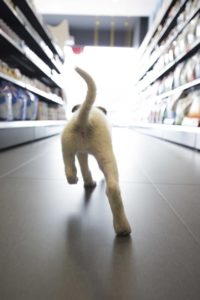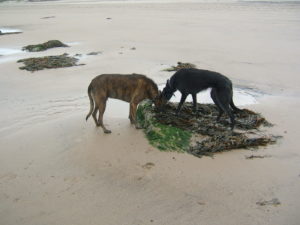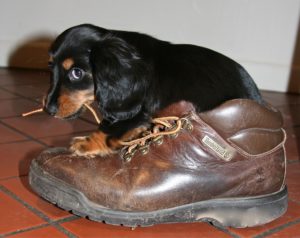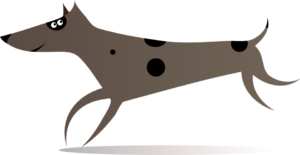Every dog has his day, and every lurcher has her or his bottom, whether a lean, wiry one like Chilli, or a great muscular kangaroo-rump like Django. And make no mistake, a good lurcher bottom is a blessing indeed. It’s somewhere to attach that whippy, waggy tail, for starters. But it has its dark side, and that’s where we must travel today. Where the sun does not shine, there is mischief. And there is poo…
We are not prudes at greydogtales. If you are of a delicate disposition, go no further. Most enthusiasts of lurchers will have been there, bought the T-shirt and mopped the floor long ago. If you are a weird fiction or horror enthusiast, and are hardened to chainsaw slaughter and transgressive fiction with body parts in it, this post may be too graphic for you, so be warned.
As a token gesture to the latter groups, we have avoided illustrations of real poo in the wild.
So, if it goes in at one end, it generally comes out of the other. Sometimes it comes out of both, but we won’t go into that. No-one really wants to talk about the dog throwing up in your shoe, however much you dress it up. Posterior events, on the other hand, are of enormous interest to everyone, as we have proven at many dinner parties and gatherings (it’s true that we don’t get many invitations nowadays, but we’re sure there’s no connection).

What is poo? Broadly speaking, it’s what healthy lurchers do to the chicken carcasses, liver treats, biscuits, minced beef and what-have-you that they shovelled into their pretty little faces yesterday. These marvels of biology have also attempted to carry out much the same process on part of your slippers, the kid’s toys, some cushion stuffing, something that fell off the kitchen counter – and a piece of string (which we shall come to later).
What you get left with in the Out tray depends, therefore, on what you put in the In tray. We feed raw (the BARF diet), which means that the ensuing poo is generally:
- firmer
- more intact, and
- less stinky
Very advantageous, you’ll agree (see also Fun with Glands below). Less advantageous is when we get the mix wrong and don’t get the bone content right or overdo one item, such as pilchards. The latter can create poo which ejects itself quite pungently, a warning that you can have too much of a good thing. A healthy, glossy coat and strong joints are all very well, but those benefits have to be balanced with the less exciting production of a sardine-patterned carpet.
We rarely get into feeding rows – BARF versus Prey-style versus Commercial. We prefer raw, which is quite cheap once you’ve got organised, but if you’re trying to do your best for your lurchers, and have studied what they need (and what they mustn’t have) nutritionally, we expect that you’re on the right road. All we’d say is that if you can afford it, try not to feed that commercial food which is all filler and ash. The ash industry does not need your support.

How to Identify Poo
We like to classify the end result of the feeding game using the following categories:
1) The Brown Windsor
This means that something has gone wrong, but it may be a passing annoyance. Thin and watery, to put it bluntly. In the short term, keeping off solids for 12 hours, or feeding small amounts of bland food* may do the trick. Please note that Brown Windsor for more than one day should be checked out, as it can lead to serious dehydration, and it may then indicate an illness or disorder (see SERIOUS BITS below). If it happens indoors, it also indicates that you will need a lot more carpet-cleaner when you go shopping that week.
2) The Freestyle Paintball
Usually a sign that items from the bin, too much rich food or the humble pilchard have been at work. A sudden change of diet can lead to a paintballing session. Again, if it’s only a day’s worth of slipping on the rubber gloves, not usually a problem. Apart from the smell. And the fact that it may have hit the wall as well.
3) The Porridge Surprise
A minor attack of paintballing without the more energetic element. Keep your eyes on it (not quite literally). Again, an over-rich diet, too much fat etc. may be the cause. Or an unauthorised adventure in the bin.
4) The Daily Squidge
The acceptable face of dog poo, bit of a nuisance to scoop up, but you can handle it. Carefully. Common enough, especially in dogs which are not raw-fed. If it’s on the squidgier side, excess kibble and other low nutrition stuff may be the culprit, but it’s quite tolerable, and shares a stable with its talented neighbour…
5) The Firm Favourite
Not too pungent, easily moved and bagged. Will not make passing strangers sniff suspiciously when you go near. Will not leak from the bag. This is the dream find when you’re struggling with a number of lurchers on a walk and want a nice quick pick-up. Can also be put in little bags for Halloween and offered as a special treat to kids you don’t like. Tell them that your doggie made it specially for them. This Category is what you’re aiming for. Top marks.
6) The Chalk Torpedo
The solid, very dry, chalky poo is the easiest to deal with of all, but not ideal. In raw-fed dogs, for example, it usually means that you have the bone content too high. Or that they’ve eaten too much chalk. It rarely means that they’ve eaten a torpedo.
You should be aiming for Categories 4 or 5 for your daily encounter. Actual size/volume of the poo is dependent on the mass of your dog and the amount of food he or she has managed to shovel down, and cannot be calculated here.
Of course, if you’re lucky, you will occasionally encounter a Category 7 or even a Category 8…
7) The String Dispenser
The joy of a Category 7 poo is that it often needs a helping hand. It occurs when the guilty party has eaten a range of what we experts call Long Things, such as:
- Actual string
- A large rubber band
- A ball of wool
- Shoelaces
- Coarse grass
The end result is that half of something ends up hanging out of the dog’s bum-hole.

More often than not it’s time to wrap a poo bag around your hand and help the little feller out. It’s a bit like being a midwife, except that no-one goes “Aww, isn’t it sweet,” at the end of the procedure (though the dog may look quite grateful and cheery). You can always wait and see if they squeeze it out themselves, but to be honest, it’s not worth walking around for an hour or two with a dog which has two tails. Get it done.
8) The Starlight Stunner
We have only ever witnessed a couple of these in their full glory. Such a rare poo results when the dog manages to get hold of sweets (or other items) wrapped in silver foil. The following night, either by torch or moonlight, you can witness the joyous shine of a reflective poo, the bits of foil sparkling away. It’s a sort of David Attenborough moment, when the world of nature seems somehow new and delightful again. If you like shiny dog poo, that is.
Disposal
Don’t compost poo, unless you have one of those fancy systems designed to utterly break down organic waste. No-one wants parsnips full of whatever was up your dog’s bum. Pick it up and either create an astonishing avant-garde sculpture in the front garden (some London art dealers go for this sort of thing), or put it in the general-purpose bin, bagged up.
We’ve said before that poo bags are a must. We use bargain nappy bags, as they’re cheaper than purpose-made dog bags (but check that they’re robust enough). As we advised over a year ago, do practice indoors first and get used to poking your fingers through them and getting something icky all over your hand. Cold, lumpy chocolate pudding is an excellent substitute to use in practice sessions. There’s always that one time…
More complex devices for scooping up poo are available, like a brush-pan on a pole, but most of them make you look like a deranged person trying to clean the pavement. Leaf-blowers set on suction do work, but you have to throw them away afterwards, which gets expensive.

Taking Django as a prime example, don’t forget that lurchers like to show off. He particularly likes to go near a road or lane edge, where any traffic can slow down and get a good look. His greatest success so far was to have a massive poo as a funeral procession was going past, driving slowly and respectfully. We stared at a tree, as if we weren’t with him, and were not amused. He seemed very pleased with himself. It seemed in poor taste to ask the undertakers what sort of score they would give him.
Fun with Glands
You may already know that around the bit where the poo comes out there are two tiny sacs called the anal glands. If you think your dog’s poo smells, you should try what these little beauties produce. And this is why we aim for Category 5. A firm Category 5 poo empties the anal glands in the process of coming into the world, through gentle pressure on the sacs. This helps avoid impaction or infection, neither of which are nice.

If your lurcher is ‘scooting’, dragging his or her bum end across the floor, then he or she may be trying to empty their glands, or feel itchy back there. Some people do home-squeezing, but we always worry about getting it wrong, especially given how sensitive the bum area is, so best get a vet to empty the sacs. Besides, if it sprays out in the clinic room, someone else has to clean the stinky stuff up.
SERIOUS BITS
We at greydogtales make no pretence to being veterinary experts or anything like that. If you’re worried about your dog’s poo, ask someone who actually knows what they’re doing. We can offer the following:
- If you get Categories 1 to 3 and the dog seems cheerful and otherwise bouncy, go with the short-term no food/bland diet approach as mentioned above. Avoiding dehydration is the most important thing in the early stages. If he or she ALSO appears noticeably unwell, sluggish or disturbed, do something about it earlier rather than later.
- Diarrhoea, or mucus-covered poo, can be a sign of intestinal parasites, especially if it persists.
- If you see actual parasites (worms and so on) in the poo, then you know what to do. Treatment.
- If you see blood in the poo, get it checked out. Dark, tarry blood may mean old bleeding further up inside the digestive tract; bright red blood indicates current bleeding in the lower tract or around the bum-hole. Neither should be left unattended.
- Always take especial care with puppies, who are more vulnerable and dehydrate more easily.
* Preferences for bland food vary. A little ground meat and rice or pumpkin is the usual approach, making sure that you don’t overdo the veg or use a fatty mince. Fat can worsen the squits.
And there you have it. Your Lurchers for Beginners guide to poo. Not everything you need to know, perhaps, but quite enough for now.


Wonderfully written (as usual)!
“The String Dispenser” -brought back memories of a Golden Retriever I once had the pleasure of owning. I shall say nothing more than the episode of “Hudson and the J-Cloth” was both amusing and disturbing in equal amounts.
Haha. With Twiglet I remember it was an incredibly long piece of couch grass which she swallowed whole. I thought she had a lawn ‘up there’. 🙂
Somewhat reminiscent of a magician’s sleeve with the (never ending) line of handkerchiefs from what I can remember of Hudson’s efforts 🙂
Starlight Stunner,
The best we have seen was after hound had rifled through the bin and hoicked out the take away curry containers which were completely demolished, I think we had the three category (excellent classifications) but Starlight Stunners were a far better result!
Weclome – delighted to hear that the phenomenon exists elsewhere. Hate to think what both curry and foil would do to ours, though, so not an experiment I’ll try. 🙂
Foiled again as per your excellent Holmes elucidations!
Haha. 🙂
I’ve had a few Starlight Stunners, but my favourite has passed into legend in our house as The Bean Bag Incident…
You ought to share for the website. It sounds…. memorable. 🙂